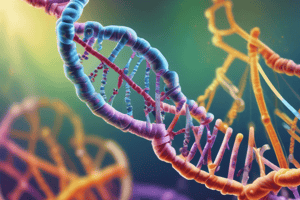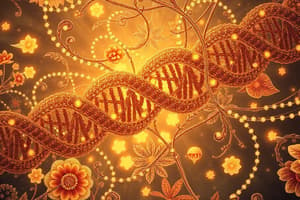Podcast
Questions and Answers
What are the three main steps involved in transcription?
What are the three main steps involved in transcription?
Initiation, elongation, termination
Which enzyme is responsible for binding to the promoter region to start the transcription process?
Which enzyme is responsible for binding to the promoter region to start the transcription process?
RNA polymerase
What is the template strand in transcription and how does it relate to the mRNA product?
What is the template strand in transcription and how does it relate to the mRNA product?
The template strand is one of the two DNA strands from which RNA polymerase reads to create the complementary mRNA strand.
What nucleotides are used in RNA during transcription?
What nucleotides are used in RNA during transcription?
During which step of transcription does the addition of nucleotides to the mRNA strand occur?
During which step of transcription does the addition of nucleotides to the mRNA strand occur?
What happens during the termination phase of transcription?
What happens during the termination phase of transcription?
What is the function of DNA replication?
What is the function of DNA replication?
How many hydrogen bonds are formed between the A-T pair in DNA?
How many hydrogen bonds are formed between the A-T pair in DNA?
What is the role of mRNA in protein synthesis?
What is the role of mRNA in protein synthesis?
What is the opposite base pair for A in RNA?
What is the opposite base pair for A in RNA?
Define DNA transcription.
Define DNA transcription.
Explain the purpose of tRNA in protein synthesis.
Explain the purpose of tRNA in protein synthesis.
What is the role of transcription factors in the process of protein synthesis?
What is the role of transcription factors in the process of protein synthesis?
Where does translation take place in eukaryotic cells?
Where does translation take place in eukaryotic cells?
Describe the three steps involved in translation.
Describe the three steps involved in translation.
What is the role of tRNA in protein synthesis?
What is the role of tRNA in protein synthesis?
How are polypeptide chains synthesized in protein synthesis?
How are polypeptide chains synthesized in protein synthesis?
In what direction are mRNAs read during protein synthesis?
In what direction are mRNAs read during protein synthesis?
Flashcards are hidden until you start studying
Study Notes
Transcription
- Transcription is separated into 3 main steps: initiation, elongation, and termination.
- Initiation occurs when RNA polymerase binds to the promoter region of a gene, signaling the DNA to unwind, allowing the enzyme to "read" the bases in one of the DNA strands.
- The enzyme is ready to make a strand of mRNA with a complementary sequence of bases.
- Transcription always proceeds from one of the two DNA strands, called the template strand.
- The mRNA product is complementary to the template strand and is almost identical to the other DNA strand, called the non-template strand.
- RNA nucleotides are A, G, C, and U, replacing T in DNA.
Elongation
- Elongation refers to the addition of nucleotides to the mRNA strand.
- RNA polymerase reads the unwound DNA strand and builds the mRNA molecule, using complementary base pairs.
- There is a brief time during this process when the newly formed RNA is bound to the unwound DNA.
- Unlike replication, mRNA doesn't remain bound to the template DNA.
- As elongation proceeds, the DNA is continuously unwound ahead of the polymerase and rewound behind it.
Termination
- Termination refers to the end of the transcription process.
- Once a gene is transcribed, the RNA polymerase needs to be instructed to dissociate from the DNA template and liberate the newly made mRNA.
- The hydrogen bonding between complementary bases holds the two strands of DNA together, but can be easily disrupted, allowing DNA strands to separate for transcription and replication.
DNA Replication and Transcription
- DNA replication is the process by which DNA makes a copy of itself (DNA to DNA).
- Transcription is the process by which DNA makes a complementary copy of RNA for use in protein synthesis (allows the cell to carry out its function/processes).
- RNA helps to carry out the instructions written in the genome (on DNA).
mRNA
- mRNA forms a complementary strand from DNA, but since it's RNA, no thymine (T) bases will be on the RNA strand.
- A will have U as its complement.
- mRNA carries the code out of the nucleus to organelles called ribosomes for the assembly of proteins.
Translation
- Translation is the production of protein from an mRNA template that was previously transcribed from DNA.
- Occurs in cytoplasm in 3 steps: initiation, elongation, and termination.
- Ribosomes (made of rRNA) carry out protein synthesis.
- Proteins carry out many functions in the cell.
Ribosomes
- Ribosomes are located in the cytoplasm in prokaryotes and in the cytoplasm and endoplasmic reticulum of eukaryotes.
- Ribosomes are made up of a large and a small subunit that come together for translation.
- The small subunit is responsible for binding the mRNA template, whereas the large subunit sequentially binds tRNAs.
tRNA
- tRNA is a type of RNA molecule that brings amino acids to the growing chain of the polypeptide.
- The basic mechanics of protein synthesis are the same in all cells with tRNA associating with ribosome to form the polypeptide chain.
- Much like its original template mRNAs are read in one direction, 5' to 3' direction.
- Polypeptide chains are synthesized from the amino to the carboxy terminus.
- Each amino acid is specified by three bases (a codon) in the mRNA, according to a nearly universal genetic code.
Studying That Suits You
Use AI to generate personalized quizzes and flashcards to suit your learning preferences.




